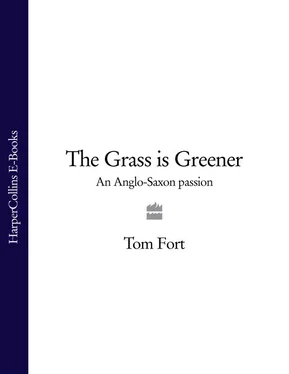Regrettably, the Jamesian advice on maintaining grass is somewhat skimpy. Beat it when it gets too high, roll it with ‘great cylinders or rolls of wood or stone’, and mow it ‘at least once a month’. These are the rules, and there is nothing wrong with them. But suspicions stir when the master proclaims: ‘It ought to be so close and even that no one blade should exceed another.’ Here, he succumbs to the proclivity of experts through the ages: for setting a completely unachievable target as if it were the easiest thing in the world, and intimating that it is merely our inadequacy or inattention which prevents us from emulating them. I would have enjoyed witnessing John James’s technique with the scythe, checking the condition of his sward, and perhaps pointing out to him that the occasional blade was a few millimetres at variance with its neighbour.
The last edition of John James’s book was published in 1743. By then fashion had moved on at a gallop. The design of gardens had become absorbed into a new cultural landscape and had become an issue for dispute. A generation of controversialists had come of age, thriving on the mockery and demolition of the traditions and tastes it had inherited. By 1743 the Duke of Chandos’s monumental extravagance at Canons had mouldered into something approaching disrepair, His Grace’s exchequer having been ruinously depleted by unsuccessful speculation (he died a year later, to be succeeded by his son Henry, who is reputed to have purchased one of his wives from an ostler as he was passing through Newbury). In a historical context, the more ludicrous aspects of the Duke’s folie de grandeur , and the reaction to them, can be seen as marking a turning point.
But the fact that John James and his publishers considered it worthwhile to issue a new edition of The Theory and Practice thirty years after the first illuminates a rather inconvenient aspect of gardening in Britain. For obvious reasons, historians seek to identify, within whatever great or trivial subject they are tackling, climacterics which can justify those satisfying words: ‘It was the end of an era.’ But in concentrating on the innovations of the innovators, the proclamations and passings of the prophets, it is easy to overlook the extreme slowness with which many changes in taste take hold. This characteristic is particularly pronounced in gardening, because of the gap between concept and realization, dictated by the speed at which plants mature.
Thus, long after the start of what the history books tell us was a new age in English gardening, ordinary Englishmen were still turning to John James to find out what they should be doing with their patch of land. They are forgotten, and in almost all cases the evidence of what they did with their gardens has been expunged. But they – the great majority among the tiny minority of the population who made gardens – continued to pay more attention to the precepts laid down in The Theory and Practice than to anything being trumpeted forth by the new pioneers.
However, it seems improbable that John James’s blueprints were duplicated across the land. Gardeners then would have done what gardeners of all ages do. They would have taken what was useful to them, what interested them and was applicable to their circumstances, financial as well as geographical; and ignored the rest. They would have learned through their own trial and error what in his theory and practice suited them. And if, having invested their time and money and love, they had discovered that the garden they had made had gone out of fashion, would they have hastened to dig it all up and start again?
Shaven Lawns and Vapid Greens
Grass is hard and lumpy and damp and full of dreadful black insects
OSCAR WILDE
During the 18th century, in reaction to principles of garden design imported from France, and under a Royal Family borrowed from Germany, a native, truly English style of marrying a house with its surroundings was born and came of age. Its apostles and disciples left an imprint on the land which endures in a recognizable form to the present day. They also stamped an impression on the national consciousness, a notion of Englishness, which took a powerful hold. I cannot claim that cultivated grass was a dominant motif; these men’s minds were set on higher things. But grass, its texture, its colour, and its convenience, did become an indispensable element of the great Georgian garden. They did not think a great deal of it. But they found that that they could not do without it.
The new movement was, of course, invented by and largely confined to a minute sliver atop society’s heap. The great illiterate mass of the population continued to do what they had always done with whatever land they had: to exploit it for dietary and medicinal purposes, and take delight in commonly available flowers and other plants. What we think of as the Georgian Garden was funded by a handful of enlightened aristocrats, executed by a few artists of taste and education who had a living to earn, and publicized by a crew of poets and prose writers accidentally infected by the passion.
The watchword of these arbiters of taste was ‘Nature’. They looked at the rigid lines, the geometric patterns, the dry symmetries so beloved of the preceding generation, and recoiled. They studied the hedges and trees shaped by sharp shears into quadrilateral figures or fabulous animals, and laughed. In the first famous broadside, delivered in the pages of the Spectator in 1712, Addison wrote: ‘Our British gardeners, instead of humouring Nature, love to deviate from it as much as possible. Our trees rise in cones, globes and pyramids. We see the marks of the scissors upon every plant and bush.’
What they meant by Nature had very little to do with the dark, tangled forests and dreary wastes of bog and rock which had been the natural condition of Britain until man got to work on it. They feared the savagery of the wilderness as much as their distant and immediate ancestors had. Their endeavour, in Pope’s famous words, was to
Consult the genius of the place in all.
The genius of that resonant sentiment is that it was capable of almost any interpretation. It licensed Lord Burlington to annihilate topiary, parterres, knots and gravel paths, and put in their place temples and obelisks copied from the monuments in the gardens of the Villa Borghese and Villa Aldobrandini which he had seen on his Grand Tour. It gave the nod of approval to the Temple of the Four Winds which Vanbrugh deposited on a windswept elevation at Castle Howard in Yorkshire; to the Merlin’s Cave which Kent hid in the grounds of Richmond Palace; to Charles Bridgeman’s amphitheatre at Claremont; to almost anything which aped the classical and proceeded in other than straight lines.
Pope expressed his philosophy more completely in Windsor Forest:
Here hills and vales, the woodland and the plain,
Here earth and water seem to strive again,
Not chaos-like together crush’d and bruis’d,
But, as the world, harmoniously confused.
The antithesis between ‘not chaos-like … but harmoniously confused’ is clever. It clears the way for Man to pursue the dictates of his imagination: the sole source – in the absence of direct divine involvement – of the harmony which can quieten pandemonium.
The mind of the little poet was as devious as the celebrated garden he created for himself beside the Thames at Twickenham, where he realized his own vision of beauty. Here, Pope would stroll from his grotto past his temple of shells along a grove of lime trees, pause awhile on the soft turf of his bowling green, inspect the obelisk put up in memory of his mother, inhale the scents of his orangery and finally seat himself in his garden house, where, enclosed by harmonious confusion, he would consider which of the innumerable targets of his vindictive disdain he would ridicule that fine day.
Читать дальше












